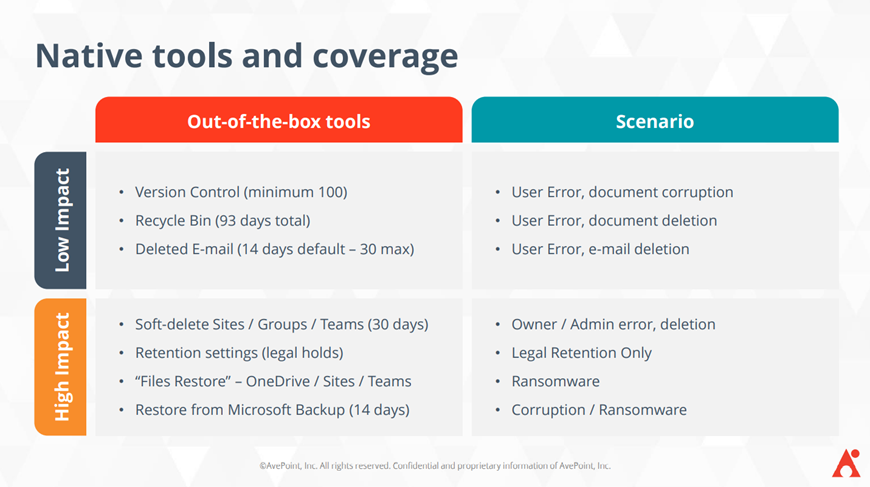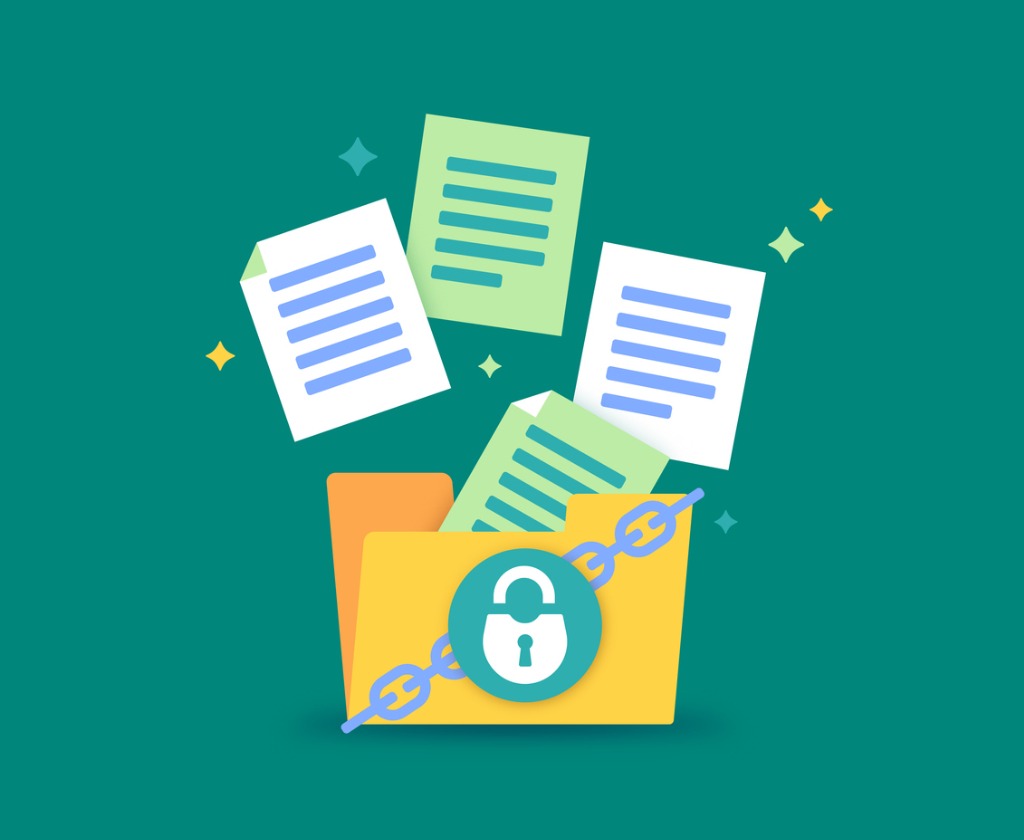If you knew the struggles of moving into the cloud when the pandemic forced businesses to shift online, you’re likely one of the many organizations now considering Microsoft 365 backup and security.
With ransomware attacks being more prevalent than ever and there being a plethora of strict regulations to navigate, AvePoint Chief Brand Officer and Microsoft RD and MVP Dux Raymond Sy and Senior Solution Engineer Antoine Snow walked through how to determine the worth of Microsoft 365 backup in their recent webinar “5 Ways To Calculate The Value of Microsoft 365 Backup.” Read on for some key takeaways.
Why Back Up Microsoft 365?
Microsoft has shaped the business scene with platforms that changed the way we work. When it comes to infrastructure—hardware, software, protection against data center failures—you can rely on Microsoft to lead with innovative solutions.
But while many people think going to the cloud and adopting Microsoft 365 instantly equates to protected data, that is only true to a certain extent. According to a Forrester report, it’s ultimately your responsibility as a user to fully protect your own data.

There’s protection Microsoft natively offers—version controls, recycle bins, file restores, soft-delete—for some common data loss scenarios like accidental file deletion and data corruption. But data loss scenarios don’t only involve file deletions. Ransomware and malware attacks, prolonged outages, and even strict data regulations all require a more comprehensive backup strategy.

Recovering from data loss, whether low or high impact, can be time-consuming, requires a lot of effort, and may affect the whole organization. Certainly, you can back up your data on your own, but relying on a trusted organization will save you money, time, and effort.
If you want a secure and convenient backup and recovery strategy, consider utilizing a good third-party backup solution. Working in this industry over the last 20 years and being the largest data management solutions provider for Microsoft 365, AvePoint offers world-class backup platforms that provide automated and comprehensive backup across different Microsoft 365 workloads.
Now, let’s go over the five factors you need to consider for your backup strategy:
1. The Value of Data
The first thing you have to think of when you want to calculate the value of your backup is to consider the value of your data. What is it worth? How important is it for your business?
The truth of the matter is that not all data is equal. The value of your data varies across different Microsoft 365 workloads. Exchange Online might be used more frequently than SharePoint. Email data might be valued more than your calendar data.
Likewise, files that are being used by your CEO or other senior management team members might be more important than documents occasionally being used by a regular employee. There’s also data bound by certain regulations your company has to adhere to, and it thus needs to be better protected.

And so, depending on the value of the data lost, there is a corresponding level of responsibility to retrieve such data. There are two kinds of errors that commonly lead to data loss:
- User-driven errors: Files or documents accidentally deleted by certain users that may be recovered through versioning or restoring from recycle bins.
- Admin errors: Teams, groups, or site collections, even permissions that might be deleted by certain admins. Admin-level restoration is required to recover items.
As seen in the native Microsoft recovery photo above, there’s a limited window of time to recover data depending on which workload you lost it in. In addition, some restoration capabilities only allow you to recover certain versions, thus making you lose all progress up to that point.
Furthermore, there are other workloads in the Microsoft 365 suite that your organization might be utilizing. Project Online, Microsoft Teams, Planner—these might be some of the other platforms you use that have data, permissions, and metadata that need to be backed up, too.
All these considerations lead to one point: Microsoft’s native offerings aren’t quite enough if you want a comprehensive backup solution and strategy. You should not just rely on what Microsoft includes out-of-the-box because they only commit to a certain level of capability for backup and restoration.
2. The Cost of Data Loss
Below is an overview of what lost or stolen data costs to organizations:

Remember, that figure is only for outages. Think about the money spent on ransomware attacks—organizations giving in to hackers and spending millions of dollars for data hacked.

Knowing that this is the cost of data loss, the next question to ask is: how do you prevent acquiring this much cost? This is why backups are crucial—not only do they give you a safety net to prevent such disasters from happening, but they also let you bounce back quickly in cases that it does happen.
With third-party solutions like AvePoint’s Cloud Backup, you can have better control over your data. Not only does it cover Microsoft’s primary services, but it goes beyond the native offerings and lets you keep your data for as long as you need.
While recovering a file in SharePoint would require you to restore the whole folder and site collection, Cloud Backup can restore as granularly as you want—even if all you want to recover is a file version or permissions! Lastly, Cloud Backup has comprehensive restoration capabilities that cover permissions, metadata, and conversations across Microsoft 365.
3. The Cost of Microsoft 365 Backup
Okay, now that we understand the importance of backup, you might think, “Well, we can do this ourselves.” But what’s the cost to you?
Let’s do a quick cost-benefit analysis comparing your two options:
Self-hosted VM infrastructure
If you’re used to managing a lot of your infrastructure, hosting your own Virtual Machine infrastructure is basically the same. That means you’ll be responsible for everything—virtual machines, operating systems, hardware components, network charges, and of course all the costs of maintaining and upgrading.

But while the cost would be almost the same with using a fully SaaS model, there are still numerous things you need to think about when self-hosting. For instance:
- Should your backup scope be full or incremental?
- What about Microsoft 365 throttling?
- How are you going to appropriately scale in order to meet your organization’s evolving needs?
- Are you prepared for the growth of your environment?
- The cloud is continuously evolving; will you be able to keep with all the updates needed for the software and the solution?
Fully SaaS model
In a lot of circumstances, a fully SaaS model can save you money because all the costs mentioned above will be incorporated in the SaaS cost model, but without the taxing effort of maintaining the solution. Although this might be just a case of weighing the costs, there are various reasons SaaS models outweigh self-hosted infrastructures.
Cloud Backup, for example, utilizes Azure datacenter networks, has a dynamic resource availability, and does automated patching and updates. It is therefore not limited to only certain needs. It’s ready to scale accordingly and is even ready to offer unlimited storage. Security is not a worry since it’s ISO-27001 certified as well.
4. Quickly Restore Data
We’ve talked about the cost of data loss and the limitations of native restore capabilities. We’ve also mentioned the importance of comprehensiveness and the granularity capabilities of your solution.
Now let’s talk about the actual recovery time—as you’re doing the recovery, how much data can you restore in a short period of time?

One way to ensure a quick restoration process is to delegate some of the responsibilities to your users, specifically those who manage groups and those who own the data. To do this, we need technology that can enable it, such as AvePoint’s AVA.
AVA lets users restore their own lost data by crawling through your files and searching for relevant files and documents based on the keyword you used. It does not have to come with Cloud Backup as it can be downloaded on Microsoft Teams for free.
By giving users the ability to restore their own data, you make things easier both for users and IT alike. With the delegated approach, you’ll still have the security you need because those who manage teams will only see their delegated team or group that they manage.
And the beauty of it is that this data will be yours to own. AvePoint supplies the technology to help you manage and protect it better, but in the end, you are given better control over your data by letting you choose where to store it.
5. Managing Data Growth
Let’s get back to self-hosting. The scalability that is needed to keep up with your growing data must be handled well. It will be a key factor in decision-making.
Whether you like it or not, data in the cloud will continue to grow. The cloud will continuously evolve as well. And so, one of the benefits of utilizing a SaaS solution is its capability to be flexible and elastic. It can expand as your organization expands, as every good backup solution should.
For an even more detailed breakdown (and a fifth factor that we didn’t include here) be sure to watch the full webinar!
Check This Out!
- If you’re confused about retention vs. backup, we recommend you read this blog post
- Claim a free copy of our e-book titled “How and Why to Backup Your Office 365 Tenant” here
- Get more info on Cloud Backup by visiting AvePoint’s Cloud Backup product page
The new “2022 Gartner® Definition of BaaS and List of Representative Vendors” report is out, and it’s a must-read in an era of increasingly frequent ransomware attacks and data loss opportunities. Download the full report here to stay in the know.

